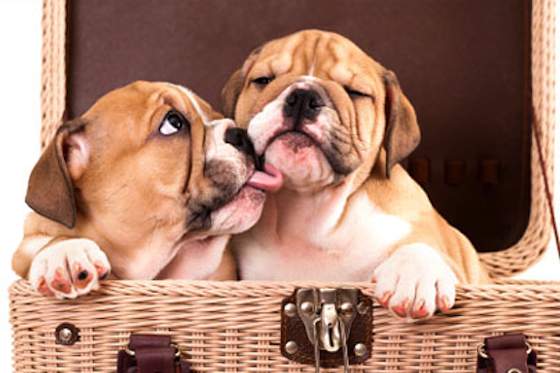- MENU
- HOME
- SEARCH
- WORLD
- MAIN
- AFRICA
- ASIA
- BALKANS
- EUROPE
- LATIN AMERICA
- MIDDLE EAST
- United Kingdom
- United States
- Argentina
- Australia
- Austria
- Benelux
- Brazil
- Canada
- China
- France
- Germany
- Greece
- Hungary
- India
- Indonesia
- Ireland
- Israel
- Italy
- Japan
- Korea
- Mexico
- New Zealand
- Pakistan
- Philippines
- Poland
- Russia
- South Africa
- Spain
- Taiwan
- Turkey
- USA
- BUSINESS
- WEALTH
- STOCKS
- TECH
- HEALTH
- LIFESTYLE
- ENTERTAINMENT
- SPORTS
- RSS
- iHaveNet.com: Pets
by Stacy Braslau-Schneck
Just because your dog can't talk doesn't mean she's not communicating. Our resident expert trainer explains

As you train and bond with your dog, one of the most important things you should understand is when she's uncomfortable with the situation she's in. Many people -- even experienced dog owners -- are not good at reading subtle signs of discomfort. They think their dog is fine with what's happening when, in fact, the dog is sometimes enduring the interaction under duress and protest. But you can learn what various body signals mean, and reading your dog's body language can help you guard him from the things that cause him distress.
Read the Signs
If your dog is happy, content and comfortable, you'll usually notice these signs:
- He looks soft, with a loose and wiggly body, warm eyes, and a gently wagging tail or even a "wagging body"
- His eyes are squinty and almond-shaped, with no whites showing
- Usually she opens her mouth loosely, but the corners aren't pulled back
- Her ears are neutral or up. A dog showing mild or comfortable curiosity perks his ears forward and might slow down other movements
Understand What Is Normal for Your Dog
It's important to keep each dog's normal expression into account, as dogs have different neutral positions for tails, ears, brow wrinkles, etc. A Border Collie or Greyhound in a calm, neutral mood will hold her tail a lot lower than a Husky or Akita, and as these dogs raise or lower their tails they might not even come close to the other breed's neutral.
When a dog holds his tail higher than normal and his ears are forward or up, it indicates confidence and interest. Tails and ears held lower than normal indicates uncertainty, fear, or nervousness.
Recognize Distress
If your dog is nervous, uncomfortable, stressed or distressed, you'll often see these signs:
- As a first step, he'll often look away from something that bothers him, as if he's trying to ignore it
- His body is stiffer and stiller
- His eyes look rounded, with the whites showing. The eyes may appear hard or cold (some people report, "He gets that look in his eyes")
- She closes her mouth
- She pins back or lowers her ears
- She might wag her tail, but it's stiffer (and sometimes held higher or lower than the comfortable neutral position). A wagging tail does not always mean a happy dog. If your dog is wagging her tail but the rest of her body is stiff, this is probably not a happy wag
If you see your dog go still and close his mouth, turn to focus on whatever might be disturbing her. If she goes from soft almond-shaped eyes to harder rounded eyes (sometimes with whites showing), it's a sign she's not comfortable with the situation. It's not a cause to panic, it's just information: Your dog is saying "I don't like this" or "This makes me uncomfortable" or "When you do that, I feel uncomfortable." Make note of what's going on and change it; redirect the dog to move farther away or stop any unwanted interactions (with you, other people or other dogs).
Reading your dog's body language can greatly help you understand how she's feeling, so you can keep her as comfortable and safe as possible.
Photo: @iStockphoto.com/Lilun_Li
AUTOS | HOBBIES | EDUCATION | FAMILY | FASHION | FOOD & RECIPES | HOME DECOR | RELATIONSHIPS | PARENTING | PETS | TRAVEL | WOMEN
PET STORIES and PET ARTICLES ...
- Dogs and the Workplace
- Exercise and the Small Dog
- Your Dog Doesn't Listen?
- Bark Management 101
- Stop Your Dog From Begging
- Are Dog Shows for You?
- Meet the Penn-MaryDel Foxhound
- What to do with a dog that won't stop barking
- 4 Tips to Keep Your Dog's Coat Healthy
- How to Train Your Dog to Hunt
- The Rottweiler: Your Family's Best Friend
- Teach Your Dog to Swim
- Show Dog Skills for Any Mutt
- Beginner's Guide to Dog Agility
- Meet the Petit Basset Griffon Vendeen
Article: Copyright © All rights reserved.
Dogs: Reading Your Dog's Body Language